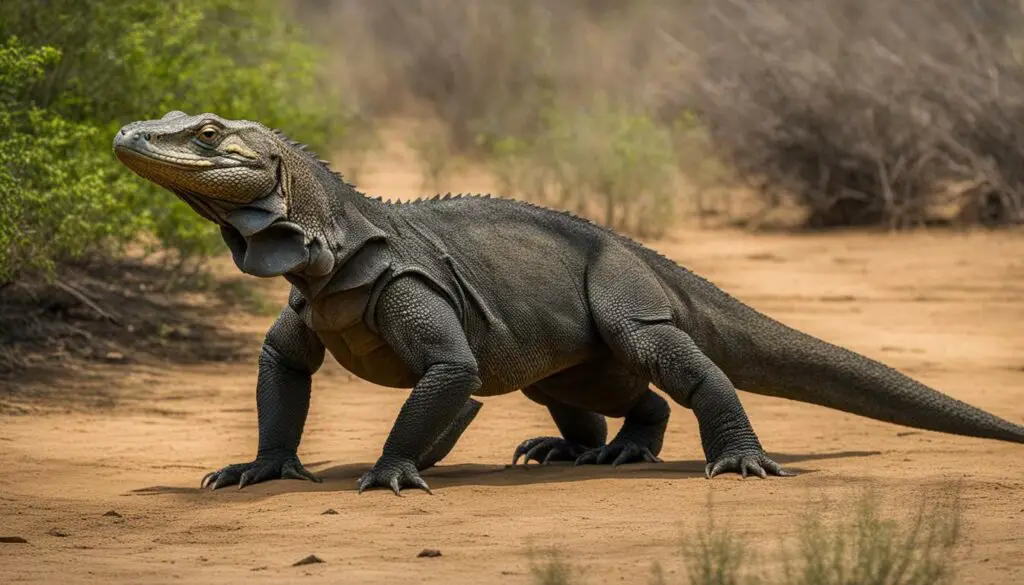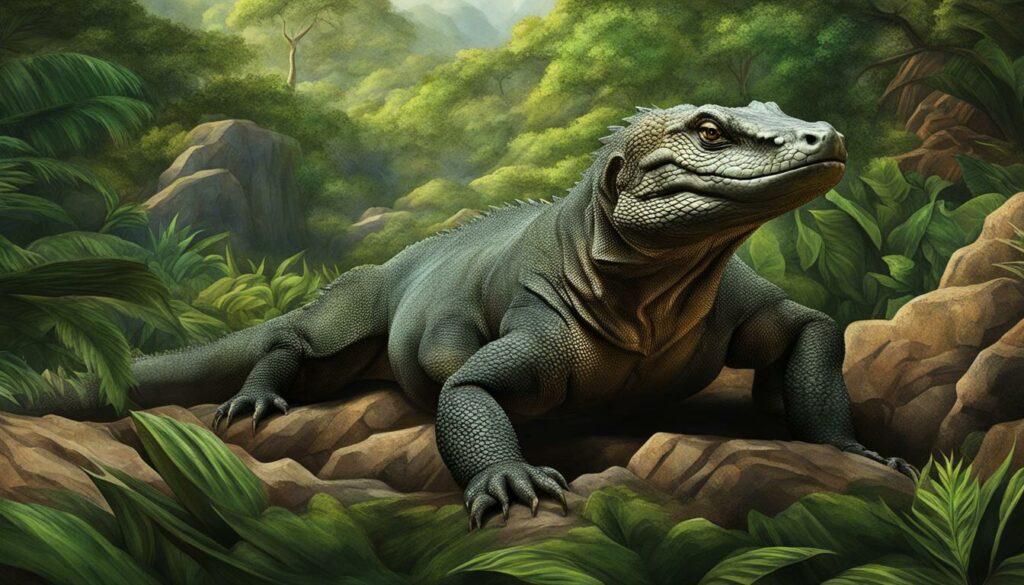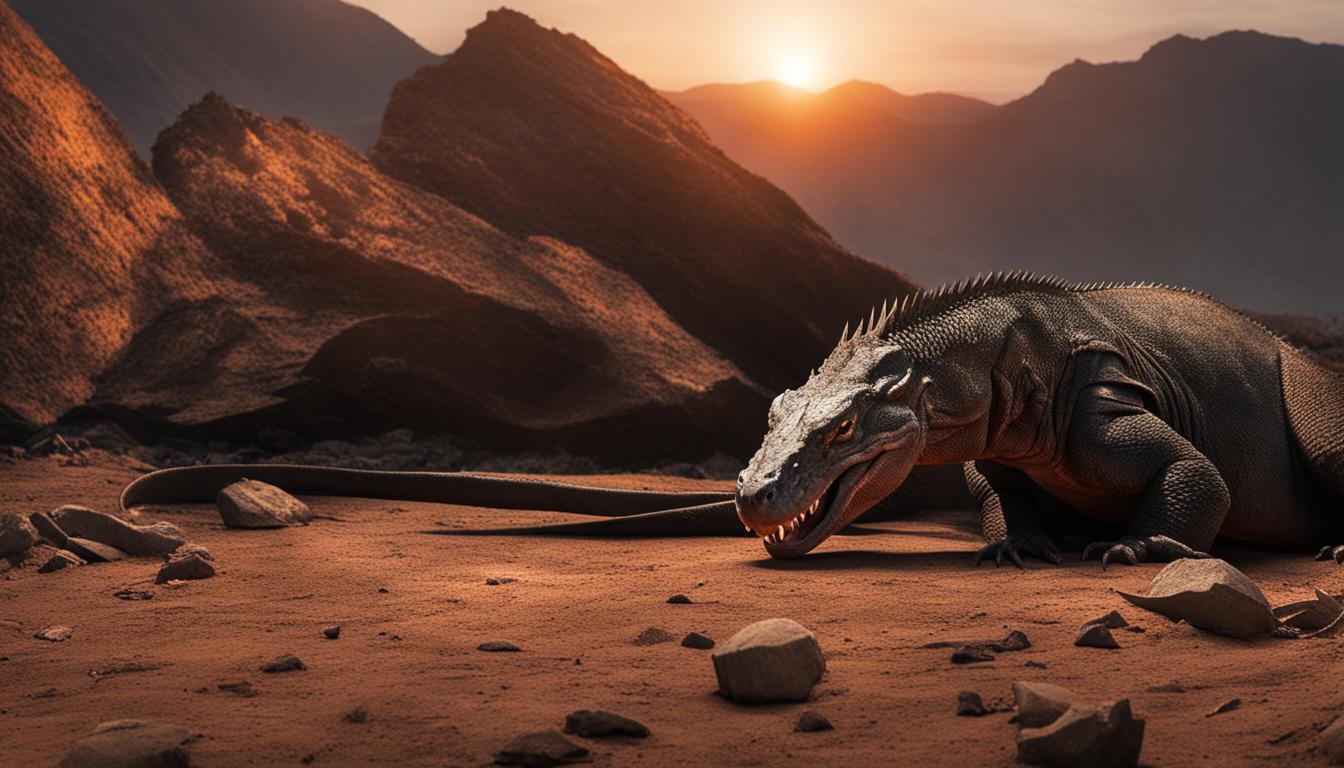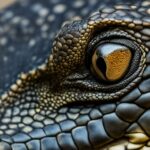Discover the fascinating world of Komodo dragons and unravel the enigma of cannibalism in these mighty creatures. These apex predators, also known as Varanus komodoensis, are the largest lizards on Earth, growing up to 3 meters long and weighing up to 70 kg. Native to the Indonesian islands of Komodo, Rinca, Flores, and Gili Motang, their feeding habits and behavior have intrigued scientists for years.
While Komodo dragons primarily feast on Javan rusa and scavenge on carrion, there have been rare instances of cannibalism within their population. Komodo Dragon cannibalism is a phenomenon that offers valuable insights into their hunting techniques and feeding patterns.
Join us on an exploration of the Komodo Dragon feeding habits and behavior, and delve into the reasons behind their occasional cannibalistic tendencies. With a better understanding, we can appreciate these magnificent creatures and their role in the ecosystem.
Komodo Dragon Feeding Habits and Behavior
The diet of Komodo dragons consists of a variety of prey, showcasing their adaptability and prowess as carnivorous reptiles. While their primary target is the Javan rusa, a species of deer, Komodo dragons also consume other mammals, birds, and invertebrates. Their hunting strategy involves ambushing their prey and delivering a venomous bite, which immobilizes their victims.
These apex predators are opportunistic feeders, making use of available food sources. When resources are scarce, Komodo dragons are known to scavenge on carrion, demonstrating their ability to adapt to different hunting conditions. However, cannibalism among Komodo dragons is rare and usually occurs when individuals are competing for limited resources or defending their territory.
| Prey | Behavior |
|---|---|
| Javan rusa | Primary target |
| Other mammals, birds, and invertebrates | Secondary prey |
| Carrion | Scavenging |
The diverse diet of Komodo dragons plays a vital role in the food chain interactions within their ecosystem. As apex predators, they help regulate the populations of their prey and maintain a healthy balance in the environment. Understanding their feeding habits and behavior provides valuable insight into the ecological dynamics of the areas where they reside.
Group Behavior in Hunting
When it comes to hunting, Komodo dragons display a unique behavior among reptiles – they often cooperate with other members of their species to take down larger prey. This cooperative hunting strategy increases their chances of a successful kill and allows them to overpower larger and stronger animals. While cannibalistic tendencies are more commonly observed in young Komodo dragons, the fact that they engage in group hunting suggests that they have a complex social structure and are capable of cooperative behaviors.
This group hunting behavior is particularly useful when Komodo dragons target larger prey, such as water buffalo. By working together, they are able to coordinate their efforts, surround the prey, and strike from multiple angles. This strategic approach maximizes their chances of a successful kill, as well as reduces the risk of injury to any individual dragon.
It is important to note that not all Komodo dragons engage in group hunting. This behavior is typically observed in areas where the density of prey is low and competition for food is high. In such environments, cooperative hunting provides an advantage in securing a sufficient food supply for the entire group. However, in areas with abundant prey, Komodo dragons are more likely to hunt individually.
Table: Comparison of Hunting Strategies in Komodo Dragons
| Individual Hunting | Group Hunting |
|---|---|
| Komodo dragons hunt alone and rely on their stealth and ambush skills to catch prey. | Komodo dragons work together to surround and overpower larger prey, increasing their chances of a successful kill. |
| Allows for greater flexibility in selecting and pursuing prey. | Enables the targeting of larger prey that may be out of reach for individual dragons. |
| Can result in competition between individuals for the same prey. | Reduces the risk of injury to any individual dragon during the hunt. |
Overall, the group hunting behavior displayed by Komodo dragons highlights their adaptability and intelligence. It suggests that these apex predators have evolved complex social behaviors to optimize their hunting and feeding patterns.
Komodo Dragon Mating and Reproduction
The mating and reproduction process of Komodo dragons is a fascinating aspect of their behavior. Mating typically occurs between May and August, with female Komodo dragons laying their eggs in September. Each clutch can contain as many as 20 eggs, which are then incubated for seven to eight months. The young dragons hatch in April, a time when insect prey is abundant.
During their early stages, the young Komodo dragons are vulnerable and often seek refuge in trees to avoid being cannibalized by adult individuals. It takes approximately 8 to 9 years for Komodo dragons to reach maturity, and they can live up to 30 years.
This reproductive strategy ensures the survival of the species despite the cannibalistic tendencies observed among adult Komodo dragons. By laying a large number of eggs and allowing for a long incubation period, the population can replenish itself and ensure the continuity of the species.

Survival Strategies of Komodo Dragons
Komodo dragons have developed various survival strategies over their evolutionary history. One of the key strategies is their ability to reproduce in large numbers. By laying multiple eggs in a single clutch, the female Komodo dragons increase the chances of offspring survival. Additionally, the long incubation period allows the hatchlings to emerge when there is an abundance of food, increasing their chances of survival.
Another important survival strategy involves the young Komodo dragons seeking safety in the trees. By climbing trees, they can avoid being targets of cannibalism by the larger and more aggressive adult individuals. This behavior demonstrates their adaptability and the importance of finding alternative strategies to ensure their survival.
Overall, the mating and reproduction process of Komodo dragons showcases their unique adaptations and evolutionary strategies. It is through these strategies that they are able to thrive in their natural habitat despite the challenging dynamics of their cannibalistic tendencies.
| Survival Strategies of Komodo Dragons | Description |
|---|---|
| Large Clutch Size | Female Komodo dragons lay multiple eggs in a single clutch, increasing the chances of offspring survival. |
| Long Incubation Period | The eggs are incubated for seven to eight months, allowing the hatchlings to emerge when there is an abundance of food. |
| Tree Climbing Behavior | The young Komodo dragons climb trees to avoid cannibalism by adult individuals, ensuring their safety. |
Komodo Dragon Attacks on Humans
While the primary diet of Komodo dragons consists of animals within their natural prey range, there have been rare instances of attacks on humans. These attacks are typically a result of mistaken identity or feeling threatened by humans encroaching on their habitat. Komodo dragons have poor eyesight but rely on their acute sense of smell to detect prey. It is important to exercise caution and respect when encountering Komodo dragons in their natural habitat and to avoid provoking or approaching them.
https://www.youtube.com/watch?v=LxMG81p0k1A
From a scientific perspective, it is highly unlikely for a Komodo dragon to actively prey on humans. Their hunting and feeding habits are primarily focused on animals within their natural prey range. Komodo dragons are opportunistic feeders and will take advantage of any available food source, but humans are not a preferred target. It is crucial to exercise caution and respect when encountering Komodo dragons to ensure the safety of both humans and the dragons themselves.
“While attacks on humans are infrequent, it is important to exercise caution and respect when encountering Komodo dragons in their habitat.”
When encountering Komodo dragons in their natural habitat, it is important to exercise caution and respect for their territory. Avoid approaching or provoking them, as this can lead to defensive behavior or potential attacks. Visitors to areas where Komodo dragons are found should follow the guidance of trained professionals and adhere to safety protocols. It is also recommended to seek immediate medical attention in the event of a Komodo dragon bite, as their saliva can cause severe infections.
Historical Incidents of Komodo Dragon Attacks on Humans
Throughout history, there have been documented incidents of Komodo dragon attacks on humans. While these attacks are rare and often a result of human encroachment or provocation, they highlight the importance of understanding Komodo dragon behavior and taking precautions when encountering them in their natural habitat.
One notable incident occurred in 2001, when a group of researchers studying Komodo dragons on Rinca Island encountered a hostile male dragon. The researchers had unknowingly entered the dragon’s territory, and the dragon, feeling threatened, attacked and bit one of the researchers. Quick thinking and medical intervention saved the researcher’s life, but the incident served as a reminder of the potential danger posed by these apex predators.
“I never expected a Komodo dragon to be so aggressive. It happened so fast, and I couldn’t believe how powerful its bite was. I’m lucky to be alive.” – Researcher, Rinca Island incident
Another incident took place in 2017 when a local guide on Komodo Island was attacked by a Komodo dragon while leading a group of tourists. The guide had ventured too close to a female dragon guarding her nest, triggering a defensive response. The guide suffered severe injuries but was able to receive prompt medical attention and made a full recovery.
These incidents serve as a reminder that caution and respect are essential when encountering Komodo dragons. It is crucial to stay within designated areas and follow safety guidelines provided by trained professionals. By understanding the reasons for cannibalism among Komodo dragons and the potential for attacks on humans, we can better protect ourselves and coexist with these fascinating creatures in their natural environment.
Examples of Komodo Dragon Attacks on Humans:
| Year | Location | Details |
|---|---|---|
| 2009 | Komodo Island | A fisherman was attacked when he accidentally stepped on a resting Komodo dragon while unloading his catch. |
| 2012 | Rinca Island | A tourist was bitten on the leg after getting too close to a Komodo dragon while taking photos. |
| 2015 | Komodo Island | An unauthorized visitor ignored warnings and approached a Komodo dragon, resulting in a serious bite injury. |
Scientific Perspective on Komodo Dragon Attacks on Humans
While Komodo dragons are formidable predators and have been known to attack animals within their habitat, from a scientific perspective, it is highly unlikely for them to actively prey on humans. Their hunting and feeding habits are primarily focused on animals within their natural prey range, such as deer and pigs. Humans are not a preferred target for Komodo dragons, as they do not view them as a viable food source. Instead, they typically see humans as a potential threat and may exhibit defensive behavior if provoked.
According to research, Komodo dragons have poor eyesight but rely on their acute sense of smell to detect prey. As a result, attacks on humans are rare and typically occur when the Komodo dragon mistakes a person for prey or feels threatened by their presence. In such cases, the dragon’s natural instinct is to defend itself, rather than actively hunt or attack humans as a food source.
It is important to note that encounters between humans and Komodo dragons in the wild are infrequent, as these reptiles primarily inhabit remote and protected areas. However, in the event of a Komodo dragon encounter, it is crucial to exercise caution and respect for their territory. Avoiding approaching or provoking them is essential to ensure both human safety and the well-being of these fascinating creatures.

Notable Quotes:
“Komodo dragons are apex predators and play a crucial role in regulating the populations of their prey.”
“While attacks on humans are rare, it is crucial to exercise caution and respect when encountering Komodo dragons in their habitat.”
Reasons for Cannibalism Among Komodo Dragons:
- Competition for resources, such as food and territory
- Intense territorial disputes among adult Komodo dragons
- Scarcity of prey, leading to cannibalistic tendencies as a survival strategy
| Reasons for Cannibalism Among Komodo Dragons | Frequency |
|---|---|
| Competition for resources | Rare, but observed in certain instances |
| Intense territorial disputes | Occasional occurrence among adult Komodo dragons |
| Scarcity of prey | More common in situations of limited food availability |
Komodo Dragon Attacks on Animals
While attacks on humans are rare, Komodo dragons have been known to attack a variety of animals within their habitat. As apex predators, their hunting and feeding patterns play a crucial role in regulating the populations of their prey.
“Komodo dragons are formidable predators and have the capability to take down mammals, birds, and reptiles,” says Dr. Jane Simmons, a wildlife biologist. “They employ a combination of stalking, ambushing, and powerful bites to immobilize and ultimately kill their prey.”
These attacks are often targeted towards animals within their natural prey range, such as deer, pigs, and other smaller reptiles. However, when food sources are scarce, Komodo dragons may resort to cannibalism or scavenge on carrion.
Komodo Dragon Attacks on Animals
| Prey | Frequency of Attacks |
|---|---|
| Javan Rusa (deer) | Common |
| Wild pigs | Occasional |
| Birds | Infrequent |
| Smaller reptiles | Rare |
The table above provides a general overview of the frequency of Komodo dragon attacks on various animals within their habitat. It is important to note that while Komodo dragons are formidable predators, their attacks on animals are necessary for maintaining a balanced ecosystem.
By preying on certain species and maintaining their population, Komodo dragons help prevent overpopulation and protect the biodiversity of their environment. Their cannibalistic tendencies, although less common, further contribute to the intricate web of interactions within the ecosystem.
Anatomy of a Komodo Dragon Attack
When a Komodo dragon initiates an attack, it follows a distinct pattern of behavior, utilizing its unique physical attributes to overpower its prey. Understanding the anatomy of a Komodo dragon attack sheds light on their hunting and eating patterns.
The attack begins with stalking, as the Komodo dragon patiently observes its target, using its keen senses to detect any signs of vulnerability. Once the perfect moment arises, the dragon swiftly moves in for the kill, relying on its incredible speed and agility to ambush the prey.
The most crucial aspect of a Komodo dragon attack is its powerful jaws and sharp teeth. Upon biting its prey, the dragon introduces bacteria-laden saliva into the wound, which is full of harmful toxins. These toxins not only incapacitate the prey but also contribute to the development of septicemia, a potentially fatal infection.
| Stage | Actions |
|---|---|
| Stalking | Observing the prey and assessing its vulnerability |
| Ambushing | Making a sudden, swift attack to catch the prey off guard |
| Biting | Inflicting a deep bite, introducing bacteria-laden saliva into the wound |
| Holding On | Using immense strength to grip the prey and prevent escape |
Once the prey is immobilized, the Komodo dragon holds on tightly, using its powerful muscles to prevent any chance of escape. The prey eventually succumbs to the effects of the venom and the dragon’s relentless grip. This carefully orchestrated attack highlights the remarkable hunting abilities of the Komodo dragon.
By understanding the anatomy of a Komodo dragon attack, we gain insight into their hunting techniques and the unique adaptations that make them such formidable predators in their ecosystem.
Precautions When Encountering Komodo Dragons
When venturing into the natural habitat of Komodo dragons, it is crucial to take precautions to ensure your safety and the well-being of these fascinating creatures. Here are some guidelines to follow:
- Respect their territory: Komodo dragons are territorial creatures, and encroaching on their space can provoke defensive behavior. Keep a safe distance and avoid approaching them, as this may lead to aggressive responses.
- Observe from a distance: While it may be tempting to get closer for a better view or photo, it is important to observe Komodo dragons from a safe distance. Use binoculars or a camera with zoom capabilities to appreciate their magnificence without disturbing them.
- Do not provoke or feed them: Avoid any actions that could be interpreted as a threat or an invitation to attack. Never attempt to feed or touch Komodo dragons, as this can disrupt their natural behavior and potentially lead to dangerous situations.
- Follow local guidance: If you are visiting an area where Komodo dragons are present, it is essential to follow the instructions of trained professionals and adhere to safety protocols. They can provide valuable guidance to ensure a safe and responsible experience.
It is also important to note that in the rare event of a Komodo dragon bite, immediate medical attention should be sought. Their saliva contains bacteria that can cause severe infections, and prompt treatment is necessary to prevent complications.
By approaching encounters with Komodo dragons with respect, caution, and adherence to safety guidelines, we can coexist with these remarkable creatures and appreciate their role in the ecosystem.
Conclusion
Understanding the behavior of Komodo dragons is crucial to coexisting with these fascinating creatures in their natural environment. While cannibalism among Komodo dragons is rare, it can occur when there is competition for resources or territorial disputes. Their hunting and feeding habits primarily focus on their natural prey, such as deer and pigs. Attacks on humans are infrequent but can happen if humans encroach on their habitat or provoke them.
By exercising caution and respect when encountering Komodo dragons, you can minimize the risk of attacks. Avoid approaching or provoking them, as this can trigger defensive behavior. If you find yourself in a situation where a Komodo dragon attacks, seek immediate medical attention as their saliva can cause severe infections. Remember that Komodo dragons play a crucial role in regulating the populations of their prey, and it is important to respect their territory and natural behavior.
Overall, by understanding the reasons for cannibalism among Komodo dragons and taking appropriate precautions, we can foster a harmonious coexistence with these powerful creatures, ensuring their survival and the safety of humans.
Are Cannibalistic Behaviors Natural for Komodo Dragons?
The discovering behavior of komodo dragons provides insights into their cannibalistic tendencies. These formidable reptiles have been observed exhibiting predatory behavior towards their own species, leading to fierce battles and sometimes even consumption. This natural instinct, rooted in survival and competition, distinguishes them as unique and fascinating creatures in the animal kingdom.
Do Komodo Dragons Have Predators Other Than Themselves?
In the world of komodo dragon predators, there are few who rival their strength and dominance. While they may occasionally engage in cannibalistic behavior, larger Komodo dragons are often seen as formidable predators to their younger counterparts. However, outside of their own species, these magnificent creatures generally have no natural predators to fear.
FAQ
Is cannibalism common among Komodo dragons?
No, cannibalism among Komodo dragons is rare and typically occurs when individuals are competing for resources or territory.
What do Komodo dragons eat?
Komodo dragons primarily prey on Javan rusa, a species of deer, but they also consume other mammals, birds, and invertebrates.
Do Komodo dragons hunt in groups?
Yes, Komodo dragons exhibit group hunting behavior, often cooperating with other members of their species to take down larger prey.
When do Komodo dragons mate and lay eggs?
Komodo dragons mate between May and August, with females laying eggs in September. The eggs hatch in April.
Are Komodo dragon attacks on humans common?
No, attacks on humans are rare and usually occur as a result of mistaken identity or feeling threatened by humans encroaching on their habitat.
Have there been incidents of Komodo dragon attacks on humans?
Yes, throughout history, there have been documented incidents of Komodo dragon attacks on humans, resulting in serious injuries or fatalities.
Can Komodo dragons actively prey on humans?
It is highly unlikely for a Komodo dragon to actively prey on humans. They primarily focus on animals within their natural prey range.
What should I do if I encounter a Komodo dragon?
Exercise caution and respect their territory. Avoid approaching or provoking them, and follow the guidance of trained professionals in their presence.
Why do Komodo dragons engage in cannibalism?
Cannibalism among Komodo dragons can occur when individuals are competing for resources or territory.
How do Komodo dragons attack their prey?
Komodo dragons stalk and ambush their prey, delivering a powerful bite and using infected saliva to immobilize and ultimately kill the prey.











